We invite you to discover an interview with Sensei Pascal Lecourt, who followed the teachings of master Kase for nearly 30 years, and was his assistant. With a personality and style of his own, Sensei Taïji Kase is an emblematic figure of Karate-Do. He has trained many karatekas around the world. Sensei Kase passed away in November 2004.
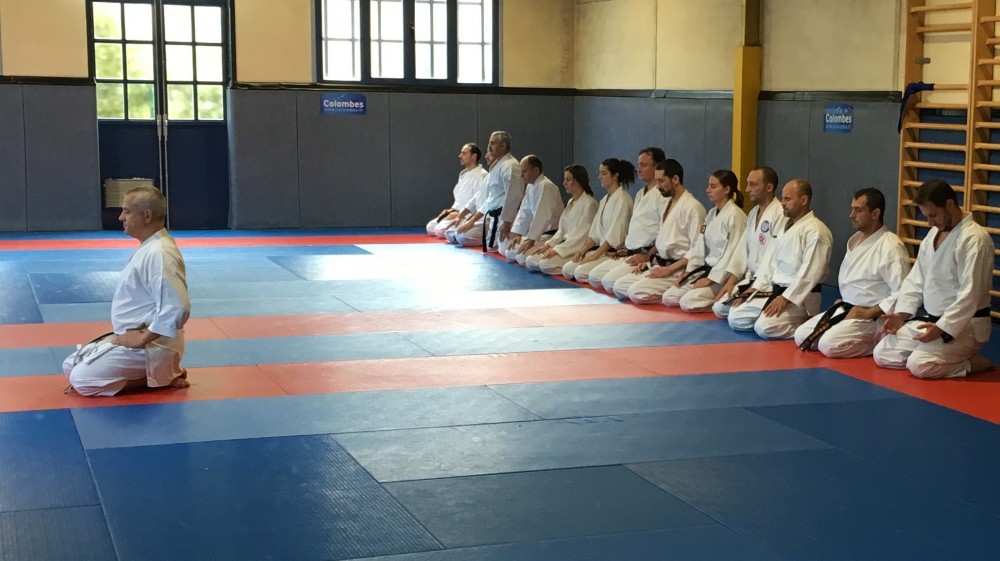
Recently awarded the rank of 7th dan, Pascal Lecourt teaches the “Kase Way” during numerous seminars in France and abroad. For several years, we have had the pleasure to welcome him during training sessions at Karate Club Colombes.
Antonio Guerrero : Good morning Pascal. First of all, I want to thank you for giving me this interview. For those who are not familiar with your background, can you tell us when and how you started karate, and what attracted you to this discipline?
Pascal Lecourt : I started practising karate do in 1975. This was during the often disturbing age of adolescence, and especially disruptive for most young adults who dream of freedom. I was an impulsive child in need of action. After three years of judo, I chose to practice karate do, which seemed closer to my aspirations. Through practice, I discovered everything I needed: realism in action, control, discipline, learning and self-knowledge.
Meeting Sensei Kase
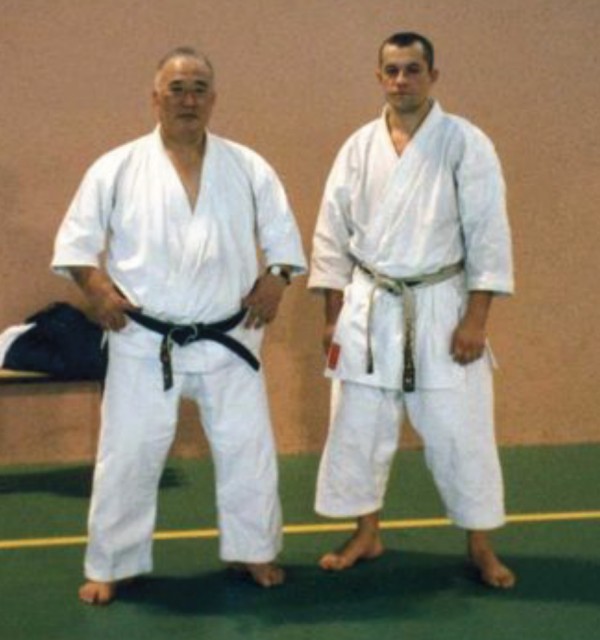 AG : Who were your professors, and how did you come to meet master Kase?
AG : Who were your professors, and how did you come to meet master Kase?
PL : I took my first steps with Sensei Gerald Dumont, a student of Sensei Kase. In June 1976, a year after my debut in karate, Sensei Dumont left Normandy to settle permanently in Brittany. So I began to attend the training sessions that Sensei Kase gave twice a month in different cities in France. Choosing master Kase felt right. I have been following him ever since.
AG : How were the courses and training seminars, compared to today?
PL : It is difficult to imagine the efforts deployed at the time by a teenager to travel across the country, sometimes on a scooter or even hitchhiking, to go “suffer” for a few hours. I have strange memories of this period. First of all, I remember the physical pain I felt during each training session. Yet I also remember how much I admired my “sempai”, their power, their technique, the energy, and the cohesion of the group around the teacher gave me the energy to continue. I saw one of them break a makiwara during a training session.
Sensei Kasé also brought to France other experts such as Sensei Enoeda, Sensei Shirai, Sensei Myazaki, Sensei Naïto or other Japanese instructors. They were present during the training seminars organized in Annecy, Royan, Limoges, Tours, Fréjus or Paris… I was going from one seminar to the next and the training was getting harder and harder.
After obtaining my first dan in 1979, I attended the courses at Crystal Palace (near London) until the mid-80s. I remember one year, during free fights, the 1st and 2nd dans were lined up in two successive rows and had to attack the highest ranks. We were on a battlefield! The grading sessions were also very violent. We passed in front of the masters: Kase, Enoeda, Shirai, Tabata and other Japanese senseis which all impressed us.
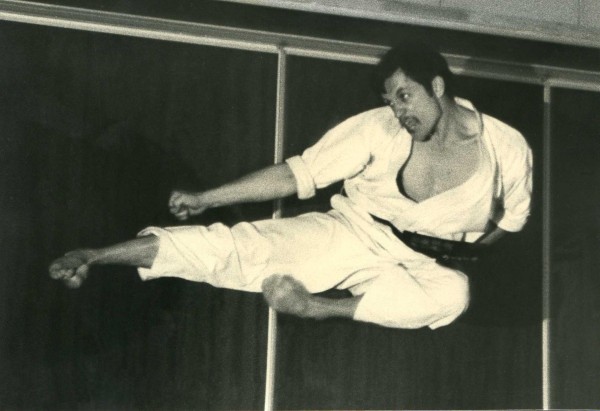
AG : Have you had the opportunity to practice karate in Japan, and if so, how was it?
PL : The only training I’ve had the privilege of attending in Japan are those that Master gave me privately in the late 80’s in his personal little dojo he built after the war in his garden. I won’t say more…
AG : Can you tell us what you remember from his teaching and the man he was?
PL : LThe values that Sensei Kase advocated both in life and in his karate allowed him to be independent, and his choices were dictated only by his convictions. He made no concession to political or financial interests. This is why he was a Master at the fringe of official institutions. He was a free, generous and righteous man. He remains a source of inspiration in the choices I make…
AG : For those who did not know him, do you have an anecdote to share with us about Master Kase?
PL : The one that comes to mind illustrates the definition of a man, both spontaneous and rigorous. This was during a return trip home after a training seminar in Portugal. Sensei asked me what time was my flight back to Paris and told me, when it was coinciding with his, that we were going to travel together: “Lucky”, he said with a broad smile. In the boarding hall of the airport we discussed the course we had just completed, and of all kinds of topics: life, men, practice… Then he talked about the kata Wankan that we had studied. He wanted give me a detailed explanation of the techniques and the specificities of this kata. When the boarding began, he continued to explain to me various details, then continued on the bus that brought us to the plane. All the passengers came out and we were the last two. He continued his explanations as if nothing had happened, and to my surprise, and that of the air hostesses, Sensei Kase began to execute the Wankan kata on the tarmac. I was beside him and I watched him perform a few meters from the plane under the passengers’ and the cabin crew’s astonished faces and amused smiles. An unreal atmosphere emerged from this scene. I then decided to show him Wankan’s passage which he wanted to explain to me in depth. He told me it was okay, so we resumed the normal course of our journey, as if nothing had happened.
The “Kase Ha” style
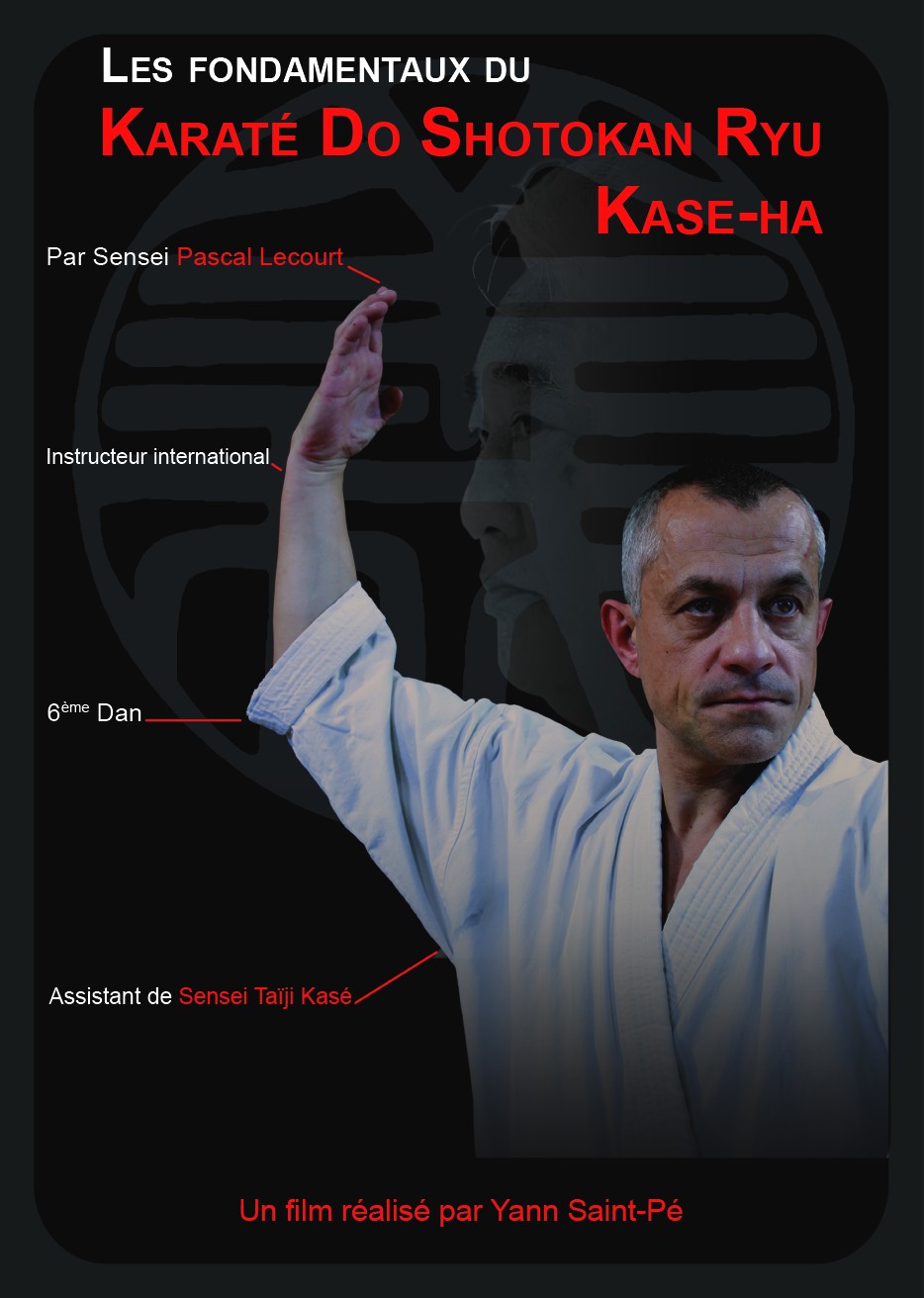 AG : Can you explain the specificities of the “Shotokan Ryu Kase Ha” style to readers who are unfamiliar with it?
AG : Can you explain the specificities of the “Shotokan Ryu Kase Ha” style to readers who are unfamiliar with it?
PL : The Kase Ha school is characterized above all by the enhanced freedom of its expression, which is why fudo-dachi is the reference stance of our style. Simultaneously powerful, low, fluid, and free, it allows for a great stability and a perfect control of the body especially while working on hip rotation exercises. Sensei Kase has developed defensive and offensive open hand techniques, based on the use of the Samurai katana and in particular of Miyamoto Musashi’s “School of Two Sabers”. The Kase Ha school also brings four major breathing principles, which are themselves divided in different types.
The Henté (attacks and/or defenses of the same arm), the different angles of blocks, and the different timing principles in the action modifying the intervention or the initiative according to the different contexts or approaches of the kumite are typical of our school.
Circular movements (Tai no sen) are part of the main principles of Kase Ha. A range of movements are studied including front or rear foot positions, all degrees of rotation, as well as forward, backward and on-the-spot pivot, allowing for a total control of the space that surrounds us.
Yet the energy and spirit of determination, indispensable in the Budo as in everyday life, are the main sources of inspiration of the Master’s school. You can also find the basic principles of the Kase-Ha school in my DVD which is on sale on my website: www.lecourtpascal.fr
AG : What are the peculiarities of the Kase school concerning the study of katas?
PL : The four forms – i.e. Bunkai, Bunkai kumite, Oyo and Oyo kumite – are studied according to the different stages of maturity of the karateka. The first two forms are studied during the initiation period which lasts for about 10 years. The Oyo form conveys freedom of interpretation and expression in the application of kata. In other words, adaptability to the opponent. Sensei Kase once told me that one of the meanings of “Oyo” was, for example, that during an attack (whatever it was) we had to use the right sequence (not necessarily in chronological order) from the kata with which we had trained, in order to adapt to the opponent. “Oyo” may also entail the instantaneous use of a sequence of techniques coming from any other kata, if the training theme fits this request. It can also mean the use of movements which are different from those that the kata proposes (especially with regards to dodging techniques), or to use the forms ura, go or go ura to respond to the opponent’s attacks in order to destabilize, slow down or stop his/her progress. Finally, this form encourages finding applications which differ from the standard Bunkais. The ultimate goal of the Oyo and Oyo kumite forms is the total freedom of expression, the immediateness of our decisions, their richness, and above all the adaptability to the opponent, but always in respect of the kata(s) of reference. It should be noted that the originality of Oyo forms can only be studied and taught by experts or masters with a thorough knowledge of all kata and their applications in all directions (omoté – ura – go no kata – go no kata ura).
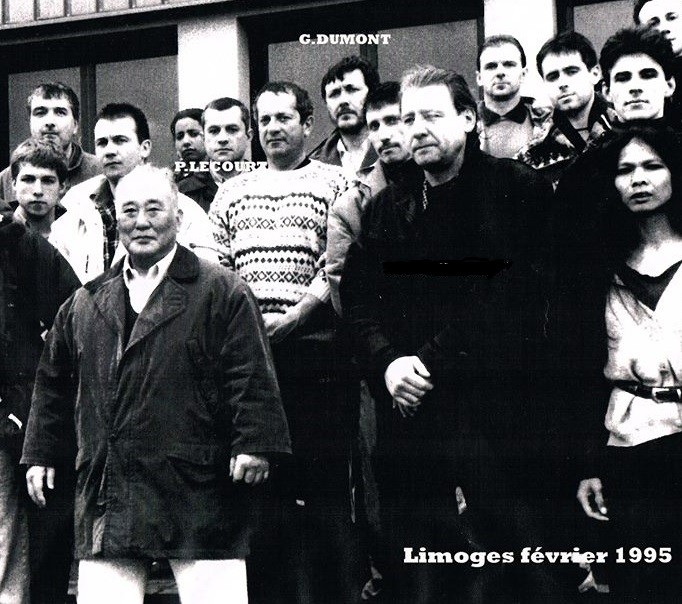
AG : Did Sensei Kase show you or teach any particular or secret techniques?
PL : If that’s the case… They have to remain secret! 😉
AG : Has he entrusted to some of his students the mission to transmit his vision of karate do, and to pursue his work and research?
PL : No, Sensei Kase left us no instructions, except to continue training… I asked him one day: “Sensei, you leave no writing, so how can we pursue your teaching and pass it on to future generations?” He replied laconically: “only look at my photo and remember”. I believe that this sentence says it all. Only our body – having absorbed so many years of experience – understands this answer…
Budo and education
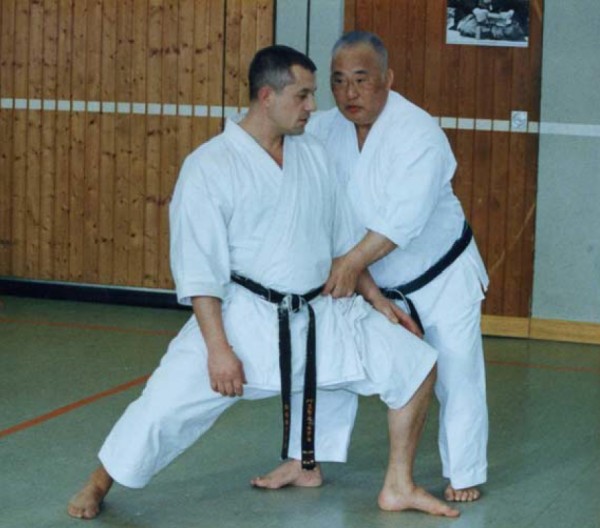 AG : Have you practiced other martial arts, and what do you recommend to the karatekas?
AG : Have you practiced other martial arts, and what do you recommend to the karatekas?
PL : I practiced judo for three years, as well as Kyūdō (traditional Japanese archery) for about ten years. I asked Master one day about the practice of other martial arts in parallel to karate. He replied that the arts which develop the same energies (that is to say, external) are incompatible, but that the practices of two arts whose energies complement one another may be associated. Bear in mind that Master’s answer makes reference to the substance (the internal mechanisms specific to Budo practice) rather than the form (technique).
AG : Did you have the opportunity to train with other great Masters?
PL :During the training seminars where Sensei Kase was present, I had the opportunity to train with senseis Enoeda, Myazaki, Shirai, Naito or Kawasoe. I also met eminent masters such as:
– Kyūdō master Suhara (in Japan in 1989), Reverend of the temple of Enkakuji
– Iaido master Otake (in Japan in 1989 on the advice of master Kase), responsible for the Tenshi Shoden Katori Shinto Ryu
– Zen master Deshimaru (in the early 80s in Paris)
– Kinomichi master Noro (in 2003 in Paris)
AG : For how many years have you been teaching karate, and can you tell us why?
PL : I have been teaching as a professional since 1981. At the time, it allowed me to pursue my passion on a daily basis. Teaching gives me the opportunity to transmit the great educational value that the Kase Ha school represents. But above all, it allows me to receive from my students the answers to the questions generated by my research in this art. Because teaching is not only about giving, it is also about receiving in return. It is a wonderful form of human exchange.
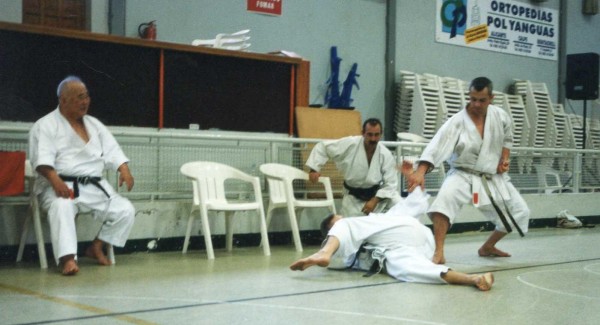
AG : Can you introduce us to your dojo in Rouen, and the courses taking place there?
PL : The dojo of Rouen opened in 1985. Since 2000, it is located at 11 ter rue de Fontenelle (in the city center, on the right bank). I organize training seminars (comprising 3 courses of 1 hour and 20 minutes each) mostly on a Saturday, 6 times a year. I also lead weekend seminars at the end of June and at the end of August. Some students from the Colombes dojo participate in these courses. At the dojo, the classes take place 4 times a week. In addition, there is a special kata course for black belts every 3 weeks approximately.
AG : What advice would you give to beginners, advanced practitioners, and teachers?
PL : First of all, study rigorously the technique. Give it as much passion and energy as possible to keep it alive. Listen to your body, as it is an ideal partner on the road to self-improvement. To black belts, follow your professor with respect and loyalty. To teachers, be honest and respectful in your practice and teaching. To everyone, never stop practising, and continue to progress together in order to reach the highest level. It is important to set an example and lead the way to all the enthusiasts who are looking up to you. We all show the way forward, so let’s respect …
AG : Some practitioners have reduced physical abilities (flexibility, age…), can they still flourish in karate?
PL : There is no typical profile for practicing any art. Adaptability is a force in life. Everyone has to do with his abilities.
The way of karate
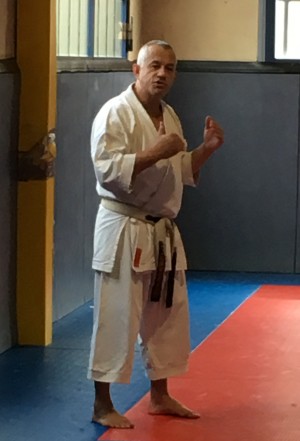 AG : Karate will be an Olympic sport at the Tokyo games in 2020. What is your view of sports karate? Do you think it will have an impact on traditional karate?
AG : Karate will be an Olympic sport at the Tokyo games in 2020. What is your view of sports karate? Do you think it will have an impact on traditional karate?
PL : The ephemeral aspect of sports karate (this term is not pejorative to me) will likely bring more karatekas in the dojos. It is our job to promote the karate of a lifetime.
AG : Has your karate changed over the last ten years, and if so, on what aspects?
PL : Sensei Kase insisted upon and encouraged personal research. Since he passed away, and while preserving his legacy, I am working on developing an even deeper karate, focused on the human mechanisms that are expressed through technique. For me, movement is the language of the body from which human nature expresses itself. It is therefore a true medium of study and work. It is an inexhaustible inner source of inspiration.
AG : You offer training seminars abroad. Can you tell us about your transmission of the Kase style through these seminars?
PL : Teaching abroad is a real privilege because it allows me to work in cross-cultural environments. Whether in Australia, Israel, Cambodia or Europe, I find it interesting to observe that the human being always functions according to the same mechanisms, even if each person has his own way of expressing these mechanisms. Ways of practising and teaching – as described in my answers to your previous questions – remain identical, and therefore the message is the same for all.
AG : Pascal, thank you again for your availability. Do you want to add something for our readers?
PL : Sensei Kase said: “Life is karate, karate is life”. So I would just say to regard and practice karate first as a Budo, then as an Art.
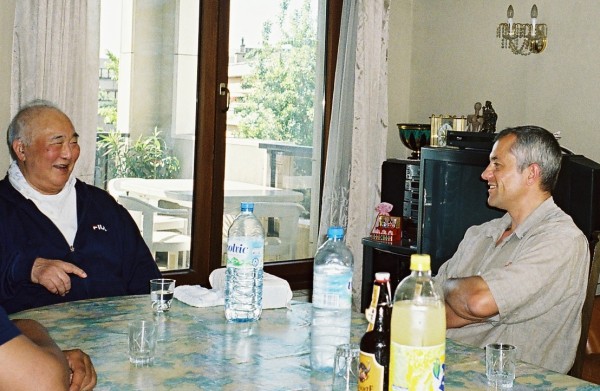
Download the interview of Pascal Lecourt in PDF format ![]()
Author of the article
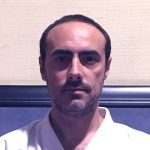
Karate Instructor
6th Dan - BEES 2
